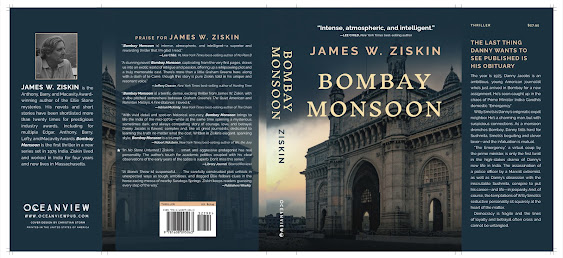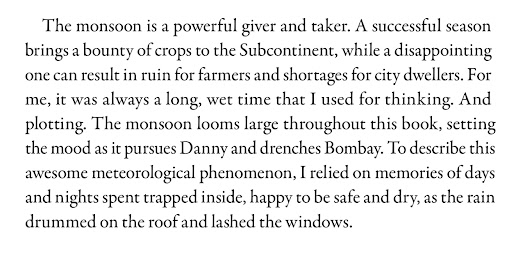Do you use weather in your books to create atmosphere or mood? Talk to us about meteorology.
This month we’ve been given a choice of two questions to answer each week. I picked the first one. The one about weather since my upcoming release is entitled Bombay Monsoon. What could be more suitable?
Weather
Bombay Monsoon (December 6, 2022, Oceanview) is set during the rainy season in India in 1975. That is during the “monsoon” in “Bombay,” in case that wasn’t clear from the title. Monsoon season, by the way, is considered exactly that, a season, in that part of the world. There’s winter (December-February), spring (March-May), monsoon (June-September), and autumn or post-monsoon (September-November).
Did you ever stop to think, by the way, that the seasons are reversed in the Southern Hemisphere? In Australia, for example, summer runs from December to February. Conversely, winter is June to September. Of course India is located entirely in the Northern Hemisphere, so this inversion of the seasons isn’t necessary. But one thing is for sure: it’s hot in Bombay (Mumbai). Hot all year round, with average temperatures in the mid-eighties to mid-nineties Fahrenheit. For our readers located elsewhere in the world, don’t worry. The conversion to Celsius is easy. Just take the reading in Fahrenheit, subtract 32, and multiply by .5556. You can do it in your head. No need to thank me.

All right, so Bombay is hot. During monsoon season it’s hot AND wet. Really wet. Bombay is drenched by—on average—seventy inches of rain each year. That’s 1.778 meters (metres) for all you spoilsports who insist on taking the fun (and migraines) out of weights and measures. Almost all of that rain falls during monsoon season. That’s June to September. Try to keep up, for God’s sake!
Now, Bombay Monsoon is a thriller set against Prime Minister Indira Gandhi’s Emergency. The Emergency was perhaps the darkest period of post-Independence Indian history. At midnight on June 25, 1975, the PM used Article 352 of the Indian Constitution to declare a domestic emergency. That Constitutional provision was intended to protect the nation’s sovereignty and security from foreign and/or domestic threats. “Internal disturbances,” as these are called in the Constitution. Mrs. Gandhi used the Emergency to imprison her political foes, suspend civil liberties, and censor the press.
That’s the backdrop for the story, but I’m supposed to be writing about weather. In Bombay Monsoon, the “monsoon” is ever present. It soaks the city and follows our protagonist, American journalist Danny Jacobs, as he gets himself into more and more trouble. (Did you catch that Danny’s a journalist? And that the Emergency imposed strict censorship on the press? Good, paying attention finally, I see. Gawd!)
The word “rain” or “rained” or “raining” appears 105 times in the book. As a point of comparison, the word “just,” that bane of writers who offer advice, appears 108 times. The book is 92,000 words long, written in the first person, so I think that’s acceptable And for the sticklers, I hasten to point out that “only”—a word no one seems to object to, even when it stands in for “just”—appears 141 times…
But back to the weather. I wrote the following as part of the author’s note in Bombay Monsoon.
In my Ellie Stone books, I’ve often used weather to set the mood. Stone Cold Dead is a non-stop exercise in describing ice and snow and frigid temperatures. Thunderstorms abound in Heart of Stone, which takes place on an Adirondack Mountains lake in August. There’s even a lunar eclipse, which actually happened on the date in my book. But—alas—the rainclouds obscured the celestial event. As for the weather in Cast the First Stone, set in Hollywood in February 1962, it does nothing but rain for the two weeks Ellie is in Los Angeles.
I definitely lean heavily on weather in most of my work, because it is—in its very nature—atmospheric. It’s a universality we all understand and recognize. Ice is cold. The sun is hot. Both extremes affect our moods and behaviors. Rain makes us want to shelter and feel protected. Wind is eerie. Sometimes welcome, other times sinister. Weather can be a shortcut—no not shortcut but another brush in our paintbox. A specialized wrench to loosen bolts. It’s always there. To ignore it would leave a hole in our stories.
Elmore Leonard famously advised writers never to start a story with weather. Maybe not. Maybe yes. But I use it everywhere else in my writing.




9 comments:
I can't wait for BOMBAY MONSOON. Remember that charming movie, Monsoon Wedding? I think that's where I got myimpression of what the monsoon rainy season is.
I loved Monsoon Wedding. Different part of India. Different subject, of course. Just say the word, Susan, and I’ll send you a digital ARC.
Jim
I lived in Mumbai from 2012 to 2015. It's hot and humid out there. I used to say to my friends about Mumbai that either the rains soak you or the sweat because of the humid weather. One is perpetually wet there until they are sitting in an ac office but it was fun living there.Looking forward to reading Bombay Monsoon.
- Vikas Nainwal
Will the books be coming out in audio? I'm eager to read it.
Can't wait to get it and save it for a rainy day!
Yes, Barb. The audiobook should come out the same date as the hardcover.
Jim
Thanks, Craig.
Craig, it never rains in California… :-)
Jim
Thanks, Vikas. Hope you enjoy it!
Jim
Post a Comment